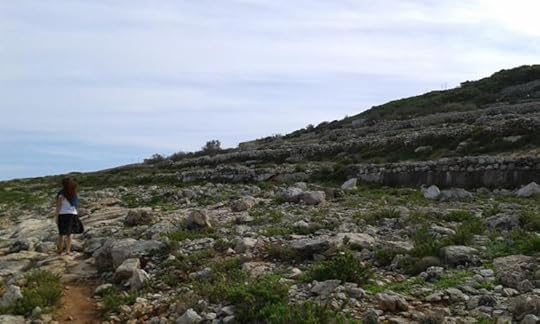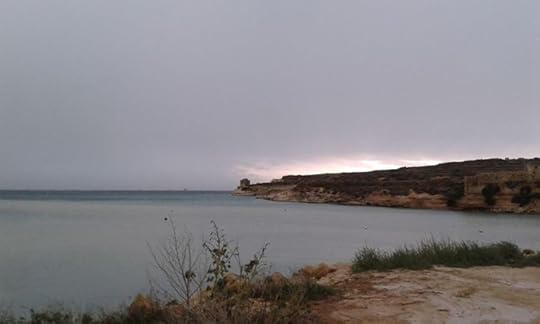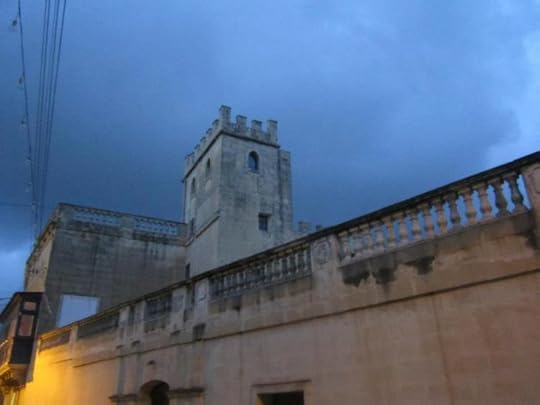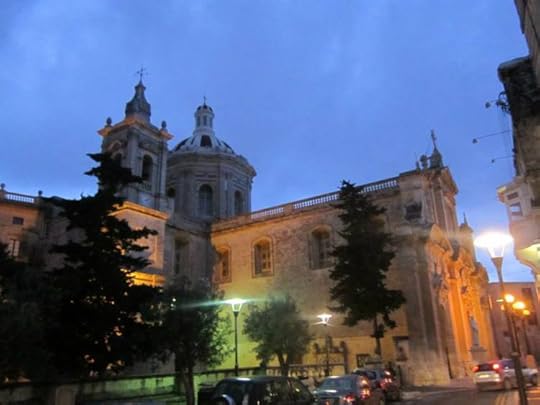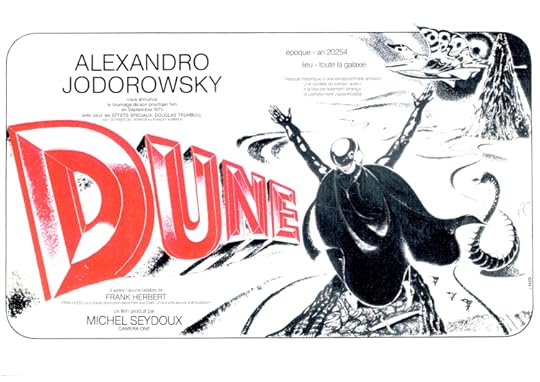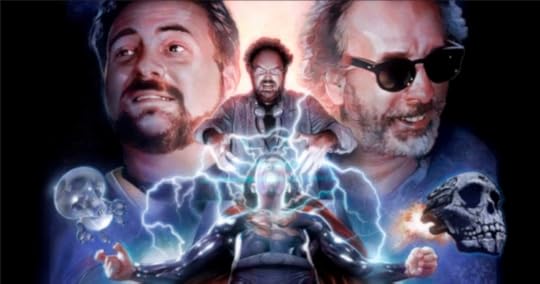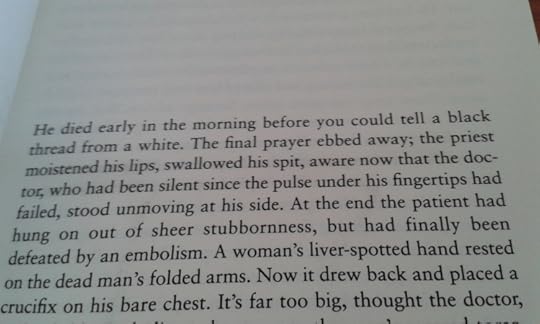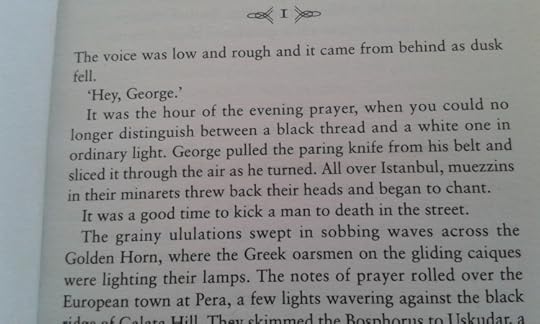Teodor Reljic's Blog, page 16
November 20, 2015
Waring
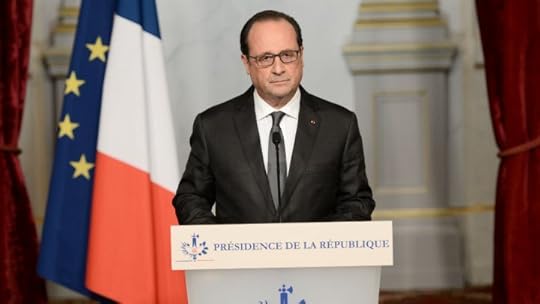
French president François Hollande characterised the November 13 Paris attacks as an ‘act of war’
“The war is up there on the island, where we’re going to meet it, but there’s no war there, nor could there be. War is dreamlike, but war IS a dream… Where is the war? In the guns and helmets and uniforms? Is it in the rock from which the ore to make the gun was mined, the grass that fed the sheep whose wool went into the uniform, or the sun that lights the battlefield? Not impossible to escape but it tethers as unsubstantially, as lightly, as a dream, the odds binding me inside. I go on with it; I’m not bound like a prisoner, but like a sleeper. Two men meet, and one will give his life for the other, or they will each try to kill the other, while the day is still blandly unfolding around them. The violence I’ve already seen has been as random and abrupt as a dream, always ending in death that seems only to become more and more impossible. I always know that I’m no more than one sharp breath from waking. It’s a breath I can never manage.” – Michael Cisco
*


September 1, 2015
Citying
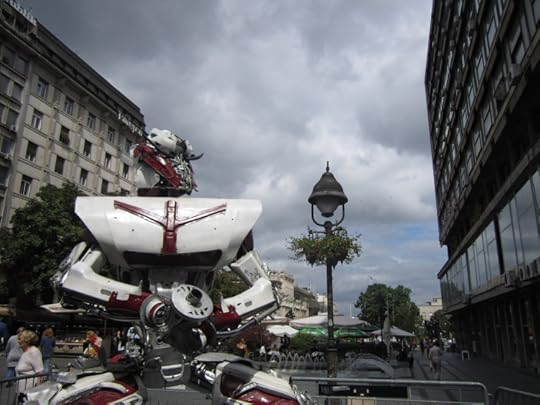
Belgrade, August 2015
“Consider the nature of a city. It is a vast repository of time, the discarded times of all the men and women who have lived, dreamed and died in the streets, which grow like a wilfully organic thing, unfurl like the petals of a mired rose and yet lack evanescence so entirely that they preserve the past in haphazard layers, so this alley is old while the avenue that runs beside it is newly built, but nevertheless has been built over deep-down, dead-in-the-ground relics of older, perhaps the original, huddle of alleys which germinated the entire quarter.” – Angela Carter
*


August 30, 2015
The lingua franca of yearning and inquiry | Marina Warner
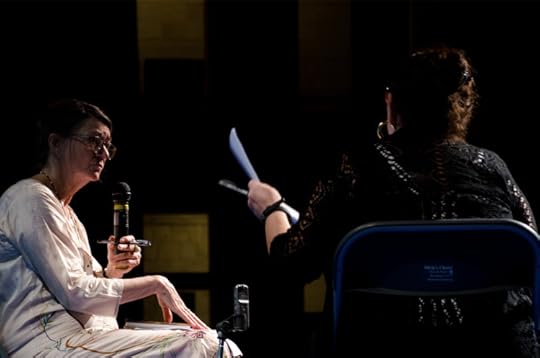
Marina Warner in conversation with Gloria Lauri-Lucente, Valletta, 29 August 2015. Photo by Virginia Monteforte
One of my most eagerly anticipated events of the year is the Malta Mediterranean Literature Festival – a multilingual gathering of authors and poets set up by the Inizjamed literary NGO, which has been steadily growing in stature over the past few years, boasting an admirable array of foreign guests on its CV while allowing local authors to showcase their work on equal footing.
Thanks to the efforts of lecturer, poet and Inizjamed head honcho Adrian Grima and his many collaborators – not least the helping hand of various local institutions – the festival is a balm against parochialism in the local sphere, as it accommodates not only the (often self-crowed) local contingent, and neither is it limited to ‘special guests’ from the expected English-speaking regions. Rather, and true to its name, it’s a refreshing gathering of writerly talents from all over the Mediterranean.
But at the risk of being criminally reductive to this year’s line-up – which included among its ranks the Booker shortlisted Libyan novelist Hisham Matar and the rousing Palestinian Egyptian poet Tamim Barghouti – I have to confess that the main attraction for me was the participation of Marina Warner – author and mythographer extraordinaire, and a consistent intellectual inspiration for me over the past few years.
Warner’s presence certainly felt like the cherry on the Festival’s cake, and having a writer of this stature on board this time around was certainly apt, given that this year also marks its tenth anniversary.
But Warner would have been a good fit for the festival either way. Though ostensibly British, the former academic, fiction writer and myth-and-fairy tale authority boasts Italian family connections, and a childhood spent in Cairo. Her recent book Stranger Magic is a study of The Thousand and One Nights, and the author doesn’t shy away from addressing the cosmopolitan sweep of the snowballing, multifaceted and latterly controversial collection of folktales of the ‘Orient’.
And in her conversation with Deputy Dean of the Faculty of Arts, University of Malta Prof. Gloria Lauri Lucente – which capped off this year’s edition of the Festival – Warner’s sensitivity to the various cultural networks found within the Mediterranean was fully borne out. But more than anything else, it was a pleasure to witness these two great women discuss both the universal and the personal as it pertains to Warner’s work – from the enduring global appeal of fairy tales, to Warner’s upcoming short story collection Fly Away Home, which taps into her experience of growing up in Cairo.
Once again showcasing her organic, interdisciplinary grasp on cultural studies, when asked why fairy tales continue to fascinate us, Warner went for a musical metaphor.
“I like to think of fairy tales as a tune,” she told Lucente. “You know the tune, I know the tune – we remember it, we can play it – it isn’t confined.” Fairy tales, Warner went on to say, suggest a kind of “lingua franca” for yearning and inquiry. “And stories are vessels for very difficult inquiries.”
Just as Stranger Magic was a sensible and considered riposte to Edward Said’s monumental critical characterization of ‘Orientalism’ – an articulation of how exoticised Western projections of the ‘East’ and the ‘Orient’ serve to facilitate cultural dominance – so Warner encourages us to not dismiss the significance of fairy tales simply because the bulk of them offer seemingly pat endings whose function is to ‘console’.
For in offering alternatives and pathways for the imagination, fairy tales can be emancipatory. In terms of their phenomenological dimension – and while stressing that she doesn’t encourage total escapism and delusion and that she remains an adherent of the Enlightenment project – Warner reminds us that, “the mind’s eye that imagines a mermaid on the shore, and that simply witnesses, and then remembers, a fisherman catching dolphin fish, is the same place.”
(It’s not a dissimilar position to the one expressed by Ursula K. Le Guin in her National Book Awards address).
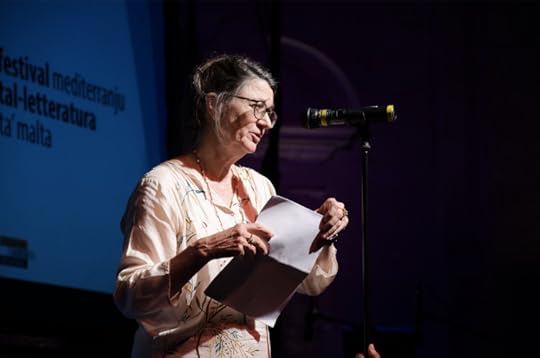
Marina Warner reads from ‘Fly Away Home’. Valletta, 29 August 2015. Photo by Virginia Monteforte
A discussion on the rift between fiction and non-fiction was another topic – also poignantly tackled by Barghouti on the first night of the festival – which allowed Warner to point out how, far from serving as a distraction from social and political strife, fiction can provide an additional leeway for discourse, especially in countries where those freedoms are otherwise suppressed.
“People are now using novels to do all sorts of things. There is censorship in so many places in the world, that fiction offers some sort of shelter.” But fiction has yet another, more subtle advantage.
“With fiction, unlike in essays, you don’t have to ‘make up your own mind’. And I do find it much more satisfying.”
But as if to illustrate Hisham Matar’s point on the previous night – that while our freedom to reinvent our cultural, social and professional identities in the modern world is a great thing, we shouldn’t forget that we remain privy to historical currents beyond our control – Warner was candid about a key motivation for her wide-ranging work.
Unlike, say, Hisham Matar himself – whose father was abducted by the Libyan regime and whose ultimate fate remains a mystery to the author and his family – Warner’s upbringing remained relatively comfortable.
“I came from a background of petite bourgeois colonialists,” she told Lucente to disarming laughter. “So I always felt like I had to make some kind of reckoning. And this has been my spur.”


August 29, 2015
Popol Vuh and Malta
‘Krautrock’ band and frequent suppliers of soundscapes for Werner Herzog movies Popol Vuh are gradually becoming my ‘return to Malta’ soundtrack.
Since I often take two or three weeks off in August to skim off at least some of the time spent under the scorching heat we’re blessed with during summer, this means I return as it’s all just receding – that inevitable twilight hum that’s perfect for moody langour.
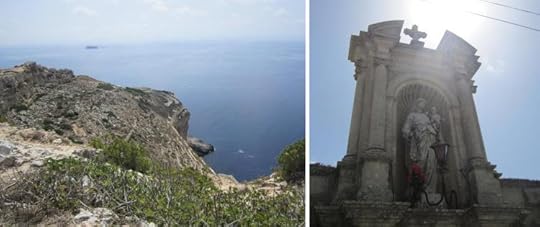
It all started with a crazy Dingli-Rabat hike in 2013
Nothing says moody langour like ’70s prog, of course, but I do find something in Popol Vuh’s sound that is particular to a Maltese landscape still stewing in summer’s juices.
Maybe it’s all about the temptation to take shelter from the sun, and in Malta said shelter would often come in the form of limestone blocks (trees would have a very practical application here, alas). And in Malta, limestone also means history, lots of it.
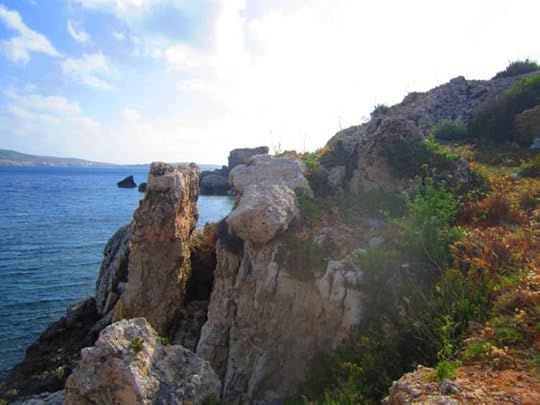
The rock is cooler than you
Shadows and barely-comprehensible ancient history – it’s no wonder that out of all of Popol Vuh’s albums, it’s their soundtrack to Herzog’s Nosferatu that I find most apt of all.


August 25, 2015
There and back again | Trip to Serbia
Just returned to the island home after a long-overdue visit to the original homeland of Serbia, and apart from the dreaded-but-expected plunge back into the heat and a grudging return to the work routine, what sticks in the mind is that heady cocktail of nostalgia and sentimentality that such a trip inspires, and which, I think, even those most impervious to such irrational (but all-too-human) reactions would find difficult to short-circuit.

Kovilj: True Detective-worthy?
Apart from the usual visit to relatives – a nicely balanced town & country trip encompassing both Belgrade and the Vrujci Spa – this time I also joined a group of fellow Maltese on a tour to Kovilj, a village near the city of Novi Sad known for its rich stork population and which boasts a proximity to the Danube.
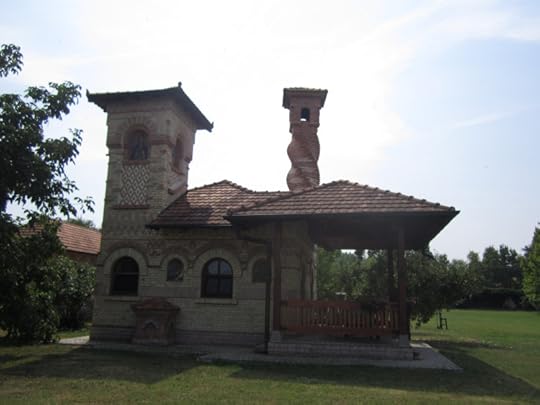
Some non-euclidian architecture courtesy of the Kovilj monks
There’s obviously something bracing about visiting your native country after six years, not least because you’re bound to change your perspective substantially since the last time you were there.
One of the reasons for my absence was that I wanted to travel a bit more. Malta -> Serbia was pretty much the extent of my travel experience for the longest time – i.e., until I was granted Maltese (and therefore EU) citizenship a couple of years ago – and having now seen a bit more of the rest of Europe, I could view the home country with a bit of a tilted perspective.

Eclectic sight in Belgrade
Belgrade itself certainly reminded me of other places now – Rome, Berlin – and so I could appreciate its beauty better for placing it into some kind of context. Edinburgh was one of my favourite recent travel destinations; Belgrade doesn’t have all that much in common with it save perhaps the comfortably compressed size of its city centre – a coziness I find essential.
Malta is infamous for its lack of greenery, and an aggressively neo-liberal policy of its current government only spells further doom for the island in this regard. So the trip to Banja Vrujci – where my maternal grandparents have been keeping a summer house for 35 years, give or take – was welcome as ever, even if the overcast weather was something of a downer.
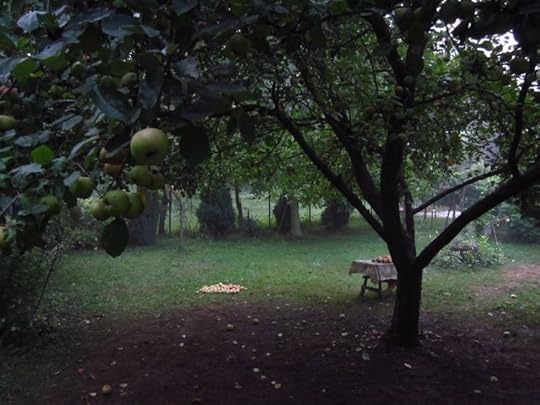
Our family plot at Banja Vrujci
But the Kovilj tour took us to other green places too – some of them housing beautiful monasteries – and it was a reminder of how Serbia, for all its problems, retains a proud farming tradition in certain areas.
One thing I didn’t do much of in Serbia is write. Between the fact that we were moving around so much and simply being on ‘holiday mode’, I can’t really say I took full advantage of a change of setting and pace to give a fresh spin to the projects I’m currently working on.

On the Danube: Algernon Blackwood was on to something
But the summer – and its attendant torpor – should be winding down soon enough. And Malta is inspiring too, in its own way. Obstinate yellow streets and buildings, flashes of beauty both random and stuffily curated, contradictions that can’t be explained and so make for great fodder. We’ll start at the Malta Mediterranean Literature Festival, then take it from there…
And amusingly enough, our Kovilj tour made it to the local online news portals…


August 10, 2015
The Films That Never Were | Jodorowsky’s Dune, Lost Soul & The Death of Superman Lives
The practically back-to-back release of three documentaries about films that never ended up being made makes for quite the wistful (and geeky) movie marathon, but it’s also a great exercise for the imagination and a jumping-off point for other artists to maybe get inspired to do something similar.
I’m talking, of course, about the trifecta made up of Jodorowksy’s Dune, Lost Soul and most recently The Death of Superman Lives. With ‘Dune’ being the most intriguing and richest of the bunch, it’s also garnered the most attention so far, in large part thanks to the charismatic, loquacious presence of its central protagonist, the cult Chilean director Alejandro Jodorowsky, as well as the totemic reputation of another key cook in the abortive Dune broth – pioneering French comic book artist Jean Giraud, aka Moebius.
Frank Pavich’s film sets the tone for this strand of documentary, balancing industry gossip with insights into the artistic process, and so feeding our curiosity from two different angles. We get to hear about ‘Jodo’ wrangling with studio execs, convincing the likes of Salvador Dali, Orson Welles and Pink Floyd to join what was already becoming a movable feast of a film.
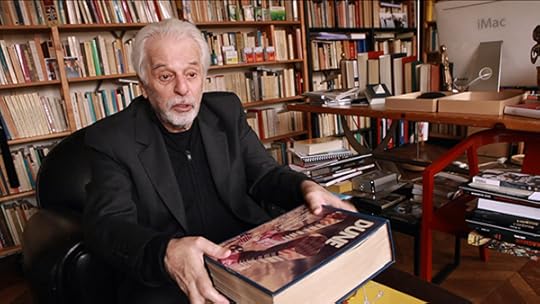
Alejandro Jodorowsky, seen here with the totemic book of storyboards for Dune
But by dint of the fact that Moebius had completed the storyboards for the film long before the film went into (ultimately doomed) production, Pavich’s film also has the luxury of being the most visually arresting of the three films we’re discussing here, giving us a presumably accurate approximation of what Jodoroswky’s film may have looked like.
Jodorowsky’s Dune is also, perhaps, the most ‘culturally significant’ film of the three, because the fallout of the project then paved the way for likes of HR Giger and Dan O’Bannon to assert their influence on that other sci-fi behemoth – Ridley Scott’s Alien – to say nothing of how the would-be Dune’s reputation had a ripple effect that helped give rise to the likes of Star Wars.
Though all of the three projects were ultimately felled by a common enemy – film studios getting cold feet over what were essentially sprawling, avant-garde projects – this predicament is felt most keenly in Lost Soul, directed by David Gregory and charting the demise of director Richard Stanley’s attempt to make The Island of Dr Moreau.
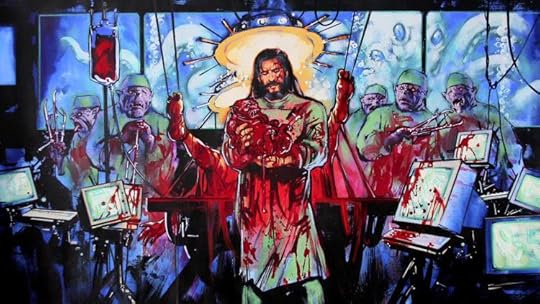
Concept art for Richard Stanley’s The Island of Dr Moreau
Eventually released in 1996 thanks to the efforts of a new director, John Frankenheimer, the Marlon Brando-starring stinker had a far more interesting – read: disastrous – behind-the-scenes story, owing in no small part to its exotic Australian location. Being the most ‘advanced’ project of three – for whatever it’s worth, the film was actually completed – its make-up is slightly different to that of Jodorowsky’s Dune or The Death of Superman Lives… but only to a point.
We’re here to lament the loss of Stanley’s proposed visionary take on HG Wells’s classic novel, the film suggests, and the fact that a bastardized version was sent to die to the theaters is irrelevant – if anything, it’s yet another twist of the knife.
Lost Soul is mostly talking heads and some piecemeal archive footage – there’s a disappointing scarcity of concept art on display – but its narrative does boast a universally appealing backbone: the tragic story of a misunderstood eccentric crushed by bean-counting and nervous executives (there’s a more tenuous connection too – Stanley can also be counted among the talking heads in Jodorowsky’s Dune).

Richard Stanley, holding the Dog Man mask he used to sneak his way onto the set of The Island of Dr Moreau after he was fired
Though Jodorowsky is hardly the pinnacle of well-adjusted normality, and though would-be director of Superman Lives Tim Burton has built a career out of marketing himself as an ‘outsider’, it’s only Stanley who comes across as the true eccentric of the bunch. Dressed all in black and sporting a hat at all times, a believer in the power of witchcraft (as bolstered and made somewhat more intellectually palatable by his background as an anthropologist), Stanley arrives to the project with plenty of interesting things to say, and a passion to lend a relevant, contemporary spin on Wells’s story while fully respecting its historical and intellectual history.
Things are, of course, not as black and white as all that, and what also emerges is how unsuited Stanley was for such a large scale project. Fresh off cult hits Hardware and Dust Devil, Stanley was a stranger to big studio films and hardly inspired confidence on set – refusing to have meetings and clearly not being comfortable with the demands of such a production.
To say nothing of dealing with the egos of the likes of Val Kilmer, whose fee ballooned the budget to ridiculous proportions, putting further pressure on an already strained shoot (to say nothing of the fact that he had reduced shooting days, and acted like a complete dick on set).
Still, the documentary suggests that Stanley had a healthy clutch of supporters, and that even the film’s producers were sympathetic to his overall aims and wanted what was best for the film.
Actress Fairuza Balk, who found a kindred bohemian spirit in Stanley, comes across as his most impassioned defender in Gregory’s film, and her immediate reaction to Stanley being eventually fired from the production makes for a hilarious anecdote.
By contrast to the two other films, The Death of Superman Lives is a conversation with high-powered industry individuals who, despite the project never getting off the ground (hur hur) remained comfortable in their careers and weathered this (very expensive) storm in the end.
Whereas Stanley went into exile after being fired from ‘Moreau’ – first in Australia, then to the Montsegur commune in France – Tim Burton was allowed to continue his career in the rarefied atmosphere of Hollywood virtually unimpeded… although, as one-time screenwriter for the project Wesley Strick tellingly suggests, he hasn’t scaled the heights of its potential ever since.
Directed and narrated by Jon Schnepp – who is seen chatting to all of the interviewees – the partially Kickstarter-funded documentary has a rough-around-the-edges feel to it.
Sound quality fluctuates throughout and a disproportionate amount of the running time is dedicated to the costume Nic Cage would have worn for the film – perhaps betraying the ‘fanboy’ nature of Schnepp’s project (where dwelling on seemingly superficial accoutrements becomes a matter of cultish fetishisation).
But barring Nic Cage – whose presence is nonetheless felt through the use of now-totemic archive footage of costume fittings – Schnepp manages to assemble all of they key players involved in the cancelled production to have their say (on this point he gets one over ‘Lost Soul’, in which the absence of Kilmer and fellow actors David Thewlis and Ron Pearlman is keenly felt).
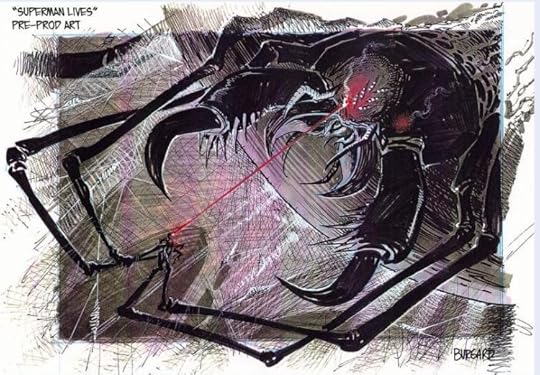
Giant spider! Pre-production concept art for Superman Lives
If nothing else, the film is a treasure trove of concept art. The jump to a high-budget production of this kind from Dune and ‘Moreau’ is made all the more evident by just how many varied talents were brought in to help bring Burton’s vision to life, and Schnepp succeeds in bringing the wild, colorful panoply into relief.
But for better or for worse – and despite a somewhat woozy presence from Burton himself – the key attraction remains producer Jon Peters. A former hairdresser with claims to bona fide street cred (at one point he tells Schnepp he was in “five hundred fights”), he comes across as a well-meaning nuisance at best, a bully at worst. He’s a fervent believer in the project but clearly also the product of the deluded Hollywood machine; 20 percent substance and 80 percent bullshit.
Tales of wondrous projects squashed by the machinery of ‘reality’, these films give breathing space to a pop culture landscape rapidly losing any heterogeneity in the name of financial security.
Perhaps they’re also a by-product of the internet age, in which nothing remains hidden for long, and where film fans become pseudo-historians and archivists by proxy. Whatever the case, I hope that they end up serving as cautionary tales above all, rather than just harmless curiosities.


May 12, 2015
Black thread/White thread: Book sale serendipity
From The Collector of Worlds by Iliya Troyanov:
From The Snake Stone by Jason Goodwin:
Insinuations of plagiarism aren’t exactly what I’m after, or even interested in, to be honest. The line in question recalls a particular passage from the Quran anyway, and we can extrapolate all sorts of symbolic readings in relation to this, and in both books.
What’s creepy is that I nabbed both books at a campus book sale, on the very same day.
As Borges as you like, but also a reminder of the kind of delightful randomness that sometimes comes out of buying books ‘old school’.


May 11, 2015
Turning Thirty to Rampant Development and Literary Nourishment
I turned 30 this May, to a welcoming committee of good friends at a terracotta-walled chillout bar – the same colour that adorns my old room at home and the same colour that will adorn my new room as I settle into the sleepy coastal town of Marsaskala with my girlfriend and Olivia, the fluffy ginger cat.
Or, at least, it will remain sleepy for the odd few months or so, until yet another ludicrous development takes over the ever-diminishing unspoilt land on the island, this time right under my (new) doorstep.
More on that later, for now here’s a few things that have kept me busy over the past month.
*

Photo by Jacob Sammut
Schlock Magazine’s May issue – The overall brief was ‘Spring’, and I think we’ve succeeded in creating an eclectic and visually sumptuous edition, if I may say so myself. Check it out and give us your feedback, if you’re so inclined. It would be appreciated either way, as we’re planning some pretty big changes in the near future any constructive crit will go a long way. Click here to check it out.

Mark Pritchett in Malta. Photo by Ray Attard
Some cool interviews – Got to chat to the great Jeremy Robert Johnson about his blistering bizarro-noir debut novel Skullcrack City (once again, for Schlock) and the day job got a bit more interesting when I scored the chance to speak to David Bowie’s former guitarist turned newspaper mogul Mark Pritchett. It made for a curious afternoon, though as ever, the more memorable insights were kept off the record.

Vemilion by Molly Tanzer. Cover by Dalton Rose, design by Osiel Gomez
Fun reads – Apart from the aforementioned Skullcrack City, I thoroughly enjoyed Molly Tanzer’s Vermilion – a weird western with touches of Chinese mysticism and trans-continental vampire lore. We’ll be interviewing Tanzer for Schlock Talks too, and I’ll be reviewing the book for May’s edition of Schlock’s Pop Culture Destruction. Tanzer also featured in an anthology I’ve enjoyed and chatted to my Schlock interlocutor Marco about for Schlock’s podcast – Letters to Lovecraft, edited by Jesse Bullington. My dear friend Pyt also gifted me a sumptuous coffee table volume of Umberto Eco’s The Book of Legendary Lands, which now sits atop of The Steampunk User’s Manual (ed. Jeff VanderMeer & Desirina Boskovich) – another birthday gift, courtesy of my sister and her boyfriend. These are the books that are imagination fuel as I type or sketch away.
Reads I’m looking forward to in the near future: Station Eleven by Emily St John Mandel, Cyclonopedia by Reza Negarestani, The Gift of Stones by Jim Crace and – perhaps above all – Stone: An Ecology of the Inhuman by Jeffrey Jerome Cohen. The massed effect of this reading schedule seems to point to a keener environmental awareness, and a desire to get at something obstinately ancient and ‘quiet’, as a counter-reaction to the ADD generation. And what better way to do that than through rocks?


April 28, 2015
The Joker Is Wild: Celebrating 75 Years of the Clown Prince of Crime
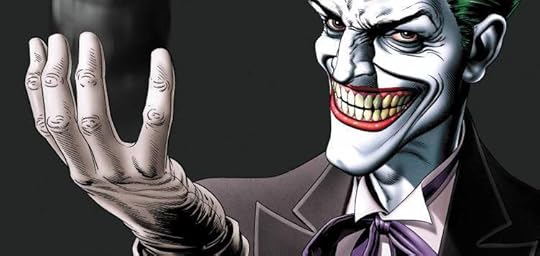
The Joker by Brian Bolland
We celebrated the 75th anniversary of the Joker with a small conference dedicated to the Clown Prince of Crime’s ‘life and works’ last Saturday, and it served as a good reminder of how refreshing academic inquiry could be when placed actually outside an academic context.
Organised by Euro Media Forum and chaired by my good friend Krista Bonello Rutter Giappone – who also gave an lucid an insightful paper on the Joker and Batman as a comedy double-act – the event may not have been terribly well attended, but it did inspire an convivial atmosphere of open discussion and debate which wasn’t about intellectual one-upmanship but genuine passion for the subject matter, and a desire to get at it – him – from as many angles as possible.
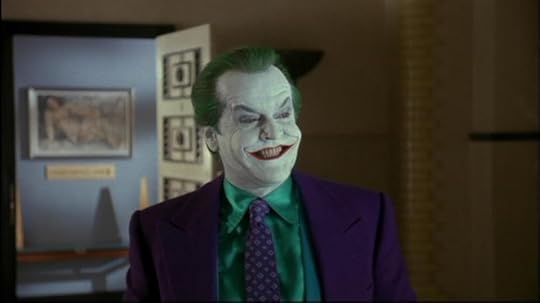
Jack Nicholson at The Joker in Batman (1989)
Running the gamut from conversational ‘geeky’ presentations and more scholarly insights into the Joker as a key character of Batman lore across various media (comics, film, animation and video game), we heard presentations which delved into Joker’s design history, evil clowns in pop culture, and how the Jack Nicholson and Heath Ledger film-Jokers compare to each other; as well as the idea of the Joker as a demiurge, the Joker’s smile as a traumatic ‘wound’ (with all the symbolic weight that the image implies) and the socio-political imagery of both the Jack Nicholson and Heath Ledger Jokers (that would be me).
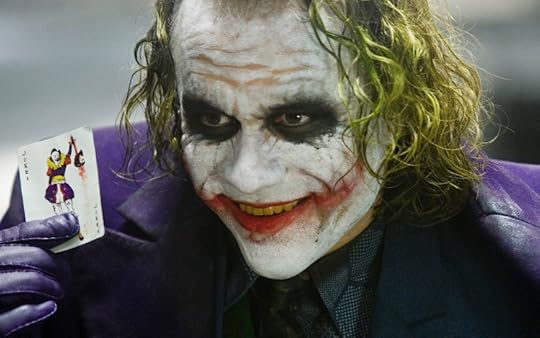
Heath Ledger as The Joker in The Dark Knight (2008)
It was an unabashedly geeky way to spend a Saturday, of course, but a part of me felt very proud of the fact that we got together to pay tribute to the Joker – one of my favourite characters in fiction – in such a concerted and dedicated way. The main take-away insight from it all – if we could reduce it to just one – is that the Joker’s familiar-but-amorphous nature is what makes him such an enduring – and enduringly scary – villain. He is equal parts prankster, psychopath, terrorist and trickster – sometimes embodying just one of those characteristics at a given time, other times (more often than not, it seems) amalgamating all of those things in garish and dangerous brew.
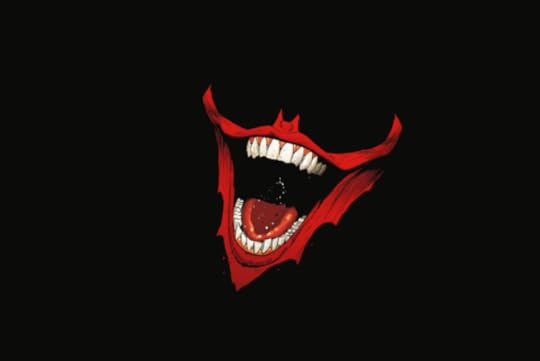
Illustration by Greg Capullo
In short, I think he’s secured himself the role of an archetype worth remembering, celebrating and returning to.


April 5, 2015
Worship My Wreck | The Pale Emperor by Marilyn Manson
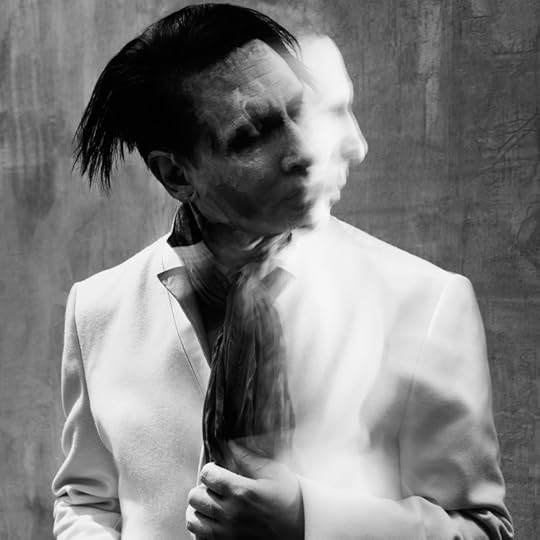
Guess who’s back: Nostalgia and slick production values rescue Manson from has-been histrionics
It was a combination of factors: slick marketing campaign that toned down the kitsch in favour of an appealing glacial menace, an evocative title that wouldn’t have been out of place in a Moorcockian post-swords and sorcery romp (and so was fun to think about) and a killer riff on its first single (‘Deep Six’). Whether it was one of these ingredients or a combination of all, I somehow found myself enjoying the latest Marilyn Manson album, The Pale Emperor, again and again.
The last time I dedicated as much time to a release from the former musical enfant terrible was when I was just pupating out of my own youth: Holywood, the final in an unofficial ‘trilogy’ of albums that still defines Manson’s contribution to pop culture: ‘Antichrist Superstar’ and ‘Mechanical Animals’ being the preceding albums… both of which I preferred to Holywood, though Holywood certainly made more of an impression than subsequent releases – the fact that it made an impression at all is already a step up, in fact.
There is something heartening about a former musical idol sort-of emerging from the has-been doldrums to release a decent album, and the fact that The Pale Emperor is not a tacky rehash of former glories while somehow also managing to ride on nostalgic appeal, is what allows it to pass muster, I think.
Despite the archly melodramatic title, Manson isn’t reaching for the same concept-album grandiosity of the ‘trilogy’ here. I’m not equipped to talk about the technicalities of the album’s sound and musical direction, but since Manson has always been conscious about ‘message’ to deliver either counter-cultural slogans or simply for shock value, I will say something about the lyrics.
The album kicks off with a Wildean refrain on ‘Killing Strangers’ – ‘We’re killing strangers so we don’t kill the ones that we love’ – which sets the poetic tone of the rest of it. It all tends towards the facile and it’s cringe-inducing at the best of times, but it’s so polished and earnest that I couldn’t help but find it charming.
Other notable nuggets:
– ‘It’s better to be blamed for robbing Peter than guilty for paying Paul’ (‘Devil Beneath My Feet’)
– ‘You want to know what Zeus said to Narcissus?’/’You better watch yourself’ (‘Deep Six’)
– ‘I feel stoned and alone like a heretic’/’I’m ready to meet my maker’ (‘The Mephistopheles of Los Angeles’)
– ‘Cannot say, I’m breaking the rules’/’If I can glue them back together’ (‘Worship My Wreck’).
What I will say about the sound is that it all comes across as less of a rock stadium courting experience, though one that still packs a punch. ‘Deep Six’, ‘The Devil Beneath My Feet’ and ‘Cupid Carries a Gun’ have a rock-and-roll sense of pure fun about them that’s infectious, and there’s also a rip-roaring appeal to ‘The Mephistopheles of Los Angeles’ and ‘Slave Only Dreams to be King’.
It’s the more vulnerable tracks that feel like innovations in Manson’s repertoire, however, with ‘Worship My Wreck’ and ‘Devil Beneath My Feet’ bolstering their confessional approach with equally ‘exposed’ vocal stylings.
I was introduced to Marilyn Manson during a blistering performance of the now-classic ‘The Beautiful People’ at the 1996 MTV Video Music Awards. An impressionable 10-year-old me was transfixed by this cross-dressing figure and his equally menacing band, ripping into the big middle finger of a song accompanied by confronting, fascist stage design as the likes of Sean ‘Puffy’ Combs looked on, aghast. He would then become something of a benchmark figure for me, and I’m sure everyone has ‘their own Manson’, whichever side of the generational divide they hail from.
For myself, Manson inculcated an appeal for gender-bending decadence which has stayed with me, and a love for gothic and subversive effects that threads through most things I love. (I never quite latched onto the anti-Christian element since I was raised in an atheist-cum-agnostic household, for better or worse).
Flawed as The Pale Emperor is, it feels good to learn that he can still punch his weight in a contemporary musical landscape. Though this time it feels less of a subversive slap on the face, and more of a welcome visit from an old friend.



